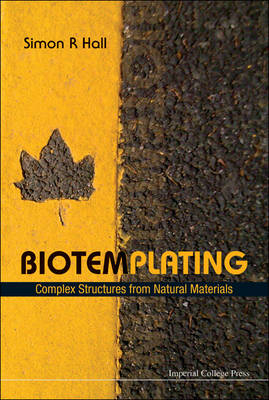
Biotemplating: Complex Structures From Natural Materials
Seiten
2009
Imperial College Press (Verlag)
978-1-84816-403-1 (ISBN)
Imperial College Press (Verlag)
978-1-84816-403-1 (ISBN)
In terms of structural complexity, the natural world presents innumerable examples of stunning beauty and high functionality, usually with the minimum of material and energy expenditure. This book covers simple molecules such as cellulose and chitin, to large biological constructs such as bacterial proteins, viruses and pollen.
In terms of structural complexity, the natural world presents innumerable examples of stunning beauty and high functionality, usually with the minimum of material and energy expenditure. Materials chemists can harness these amazing structures as ready-made scaffolds on which to grow inorganic phases which replicate the underlying complexity, thereby producing materials with greatly enhanced physical properties. This book comprehensively describes the entire range of natural materials that have been used in this way and the inorganic phases which result from them. The book covers simple molecules such as cellulose and chitin, to large biological constructs such as bacterial proteins, viruses and pollen. Practically every inorganic material has been synthesized using biotemplating methods and the book reflects this, ranging from simple oxides and carbonates such as silica and calcite, to complex semi- and superconducting materials. The book also discusses the formation of these materials from a mechanistic point of view, thereby enabling the reader to better understand the processes involved in biotemplated mineralization.
In terms of structural complexity, the natural world presents innumerable examples of stunning beauty and high functionality, usually with the minimum of material and energy expenditure. Materials chemists can harness these amazing structures as ready-made scaffolds on which to grow inorganic phases which replicate the underlying complexity, thereby producing materials with greatly enhanced physical properties. This book comprehensively describes the entire range of natural materials that have been used in this way and the inorganic phases which result from them. The book covers simple molecules such as cellulose and chitin, to large biological constructs such as bacterial proteins, viruses and pollen. Practically every inorganic material has been synthesized using biotemplating methods and the book reflects this, ranging from simple oxides and carbonates such as silica and calcite, to complex semi- and superconducting materials. The book also discusses the formation of these materials from a mechanistic point of view, thereby enabling the reader to better understand the processes involved in biotemplated mineralization.
Mechanisms and Models; Simple Mono- and Oligosaccharides; Complex Polysaccharides; Hydrocolloids; Chitin/Chitosan; Proteins and Lipids; Viruses and Bacteria; Complex Biostructures as Templates; Into the Future.
| Erscheint lt. Verlag | 2.7.2009 |
|---|---|
| Verlagsort | London |
| Sprache | englisch |
| Themenwelt | Naturwissenschaften ► Chemie ► Anorganische Chemie |
| ISBN-10 | 1-84816-403-3 / 1848164033 |
| ISBN-13 | 978-1-84816-403-1 / 9781848164031 |
| Zustand | Neuware |
| Haben Sie eine Frage zum Produkt? |
Mehr entdecken
aus dem Bereich
aus dem Bereich
Buch | Hardcover (2024)
Springer Spektrum (Verlag)
CHF 89,95


